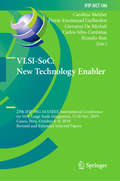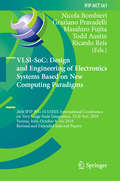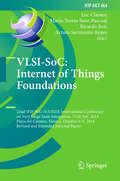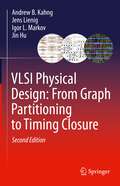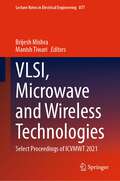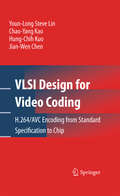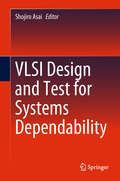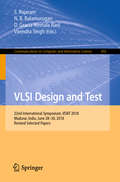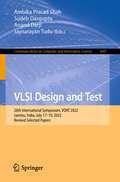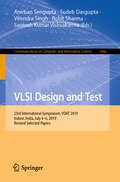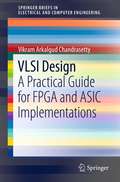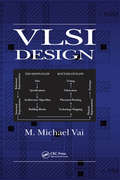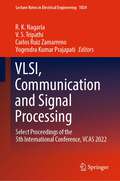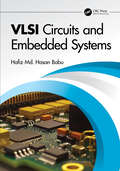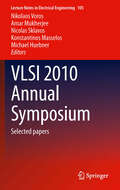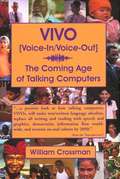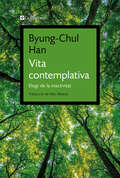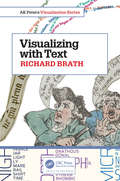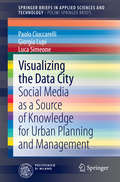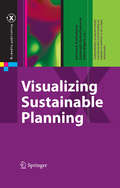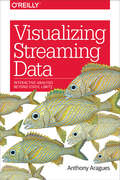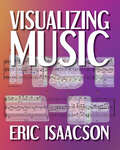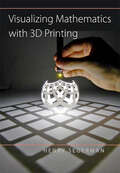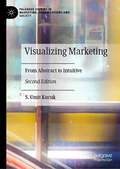- Table View
- List View
VLSI-SoC: 27th IFIP WG 10.5/IEEE International Conference on Very Large Scale Integration, VLSI-SoC 2019, Cusco, Peru, October 6–9, 2019, Revised and Extended Selected Papers (IFIP Advances in Information and Communication Technology #586)
by Carolina Metzler Pierre-Emmanuel Gaillardon Giovanni De Micheli Carlos Silva-Cardenas Ricardo ReisThis book contains extended and revised versions of the best papers presented at the 27th IFIP WG 10.5/IEEE International Conference on Very Large Scale Integration, VLSI-SoC 2019, held in Cusco, Peru, in October 2019. The 15 full papers included in this volume were carefully reviewed and selected from the 28 papers (out of 82 submissions) presented at the conference. The papers discuss the latest academic and industrial results and developments as well as future trends in the field of System-on-Chip (SoC) design, considering the challenges of nano-scale, state-of-the-art and emerging manufacturing technologies. In particular they address cutting-edge research fields like heterogeneous, neuromorphic and brain-inspired, biologically-inspired, approximate computing systems.
VLSI-SoC: 26th IFIP WG 10.5/IEEE International Conference on Very Large Scale Integration, VLSI-SoC 2018, Verona, Italy, October 8–10, 2018, Revised and Extended Selected Papers (IFIP Advances in Information and Communication Technology #561)
by Ricardo Reis Masahiro Fujita Nicola Bombieri Graziano Pravadelli Todd AustinThis book contains extended and revised versions of the best papers presented at the 26th IFIP WG 10.5/IEEE International Conference on Very Large Scale Integration, VLSI-SoC 2018, held in Verona, Italy, in October 2018. The 13 full papers included in this volume were carefully reviewed and selected from the 27 papers (out of 106 submissions) presented at the conference. The papers discuss the latest academic and industrial results and developments as well as future trends in the field of System-on-Chip (SoC) design, considering the challenges of nano-scale, state-of-the-art and emerging manufacturing technologies. In particular they address cutting-edge research fields like heterogeneous, neuromorphic and brain-inspired, biologically-inspired, approximate computing systems.
VLSI-SoC: Internet of Things Foundations
by Arturo Sarmiento-Reyes Ricardo Reis Maria-Teresa Sanz-Pascual Luc ClaesenThis book contains extended and revised versions of the best papers presented at the 22nd IFIP WG 10. 5/IEEE International Conference on Very Large Scale Integration, VLSI-SoC 2014, held in Playa del Carmen, Mexico, in October 2014. The 12 papers included in the book were carefully reviewed and selected from the 33 full papers presented at the conference. The papers cover a wide range of topics in VLSI technology and advanced research. They address the current trend toward increasing chip integration and technology process advancements bringing about stimulating new challenges both at the physical and system-design levels, as well as in the test of these systems.
VLSI Physical Design: From Graph Partitioning to Timing Closure
by Igor L. Markov Andrew B. Kahng Jens Lienig Jin HuThe complexity of modern chip design requires extensive use of specialized software throughout the process. To achieve the best results, a user of this software needs a high-level understanding of the underlying mathematical models and algorithms. In addition, a developer of such software must have a keen understanding of relevant computer science aspects, including algorithmic performance bottlenecks and how various algorithms operate and interact. This book introduces and compares the fundamental algorithms that are used during the IC physical design phase, wherein a geometric chip layout is produced starting from an abstract circuit design. This updated second edition includes recent advancements in the state-of-the-art of physical design, and builds upon foundational coverage of essential and fundamental techniques. Numerous examples and tasks with solutions increase the clarity of presentation and facilitate deeper understanding. A comprehensive set of slides is available on the Internet for each chapter, simplifying use of the book in instructional settings.“This improved, second edition of the book will continue to serve the EDA and design community well. It is a foundational text and reference for the next generation of professionals who will be called on to continue the advancement of our chip design tools and design the most advanced micro-electronics.” Dr. Leon Stok, Vice President, Electronic Design Automation, IBM Systems Group“This is the book I wish I had when I taught EDA in the past, and the one I’m using from now on.” Dr. Louis K. Scheffer, Howard Hughes Medical Institute“I would happily use this book when teaching Physical Design. I know of no other work that’s as comprehensive and up-to-date, with algorithmic focus and clear pseudocode for the key algorithms. The book is beautifully designed!”Prof. John P. Hayes, University of Michigan“The entire field of electronic design automation owes the authors a great debt for providing a single coherent source on physical design that is clear and tutorial in nature, while providing details on key state-of-the-art topics such as timing closure.”Prof. Kurt Keutzer, University of California, Berkeley“An excellent balance of the basics and more advanced concepts, presented by top experts in the field.” Prof. Sachin Sapatnekar, University of Minnesota
VLSI, Microwave and Wireless Technologies: Select Proceedings of ICVMWT 2021 (Lecture Notes in Electrical Engineering #877)
by Brijesh Mishra Manish TiwariThis book comprises the proceedings of the International Conference on VLSI & Microwave and Wireless Technologies (ICVMWT-2021). The book includes peer-reviewed papers on the core technological developments in emerging fields like wireless communication, RF microwave/radar, VLSI, optical communication, etc. The book will serve as a valuable reference resource for academics and researchers across the globe.
VLSI Design for Video Coding
by Youn-Long Steve Lin Hung-Chih Kuo Chao-Yang Kao Jian-Wen ChenHigh definition video requires substantial compression in order to be transmitted or stored economically. Advances in video coding standards from MPEG-1, MPEG-2, MPEG-4 to H.264/AVC have provided ever increasing coding efficiency, at the expense of great computational complexity which can only be delivered through massively parallel processing. This book will present VLSI architectural design and chip implementation for high definition H.264/AVC video encoding, using a state-of-the-art video application, with complete VLSI prototype, via FPGA/ASIC. It will serve as an invaluable reference for anyone interested in VLSI design and high-level (EDA) synthesis for video.
VLSI Design and Test for Systems Dependability
by Shojiro AsaiThis book discusses the new roles that the VLSI (very-large-scale integration of semiconductor circuits) is taking for the safe, secure, and dependable design and operation of electronic systems.The book consists of three parts. Part I, as a general introduction to this vital topic, describes how electronic systems are designed and tested with particular emphasis on dependability engineering, where the simultaneous assessment of the detrimental outcome of failures and cost of their containment is made. This section also describes the related research project “Dependable VLSI Systems,” in which the editor and authors of the book were involved for 8 years. Part II addresses various threats to the dependability of VLSIs as key systems components, including time-dependent degradations, variations in device characteristics, ionizing radiation, electromagnetic interference, design errors, and tampering, with discussion of technologies to counter those threats. Part III elaborates on the design and test technologies for dependability in such applications as control of robots and vehicles, data processing, and storage in a cloud environment and heterogeneous wireless telecommunications. This book is intended to be used as a reference for engineers who work on the design and testing of VLSI systems with particular attention to dependability. It can be used as a textbook in graduate courses as well. Readers interested in dependable systems from social and industrial–economic perspectives will also benefit from the discussions in this book.
VLSI Design and Test: 22nd International Symposium, VDAT 2018, Madurai, India, June 28-30, 2018, Revised Selected Papers (Communications in Computer and Information Science #892)
by S. Rajaram N. B. Balamurugan D. Gracia Nirmala Rani Virendra SinghThis book constitutes the refereed proceedings of the 22st International Symposium on VLSI Design and Test, VDAT 2018, held in Madurai, India, in June 2018.The 39 full papers and 11 short papers presented together with 8 poster papers were carefully reviewed and selected from 231 submissions. The papers are organized in topical sections named: digital design; analog and mixed signal design; hardware security; micro bio-fluidics; VLSI testing; analog circuits and devices; network-on-chip; memory; quantum computing and NoC; sensors and interfaces.
VLSI Design and Test: 26th International Symposium, VDAT 2022, Jammu, India, July 17–19, 2022, Revised Selected Papers (Communications in Computer and Information Science #1687)
by Ambika Prasad Shah Sudeb Dasgupta Anand Darji Jaynarayan TuduThis book constitutes the proceedings of the 26th International Symposium on VLSI Design and Test, VDAT 2022, which took place in Jammu, India, in July 2022.The 32 regular papers and 16 short papers presented in this volume were carefully reviewed and selected from 220 submissions. They were organized in topical sections as follows: Devices and Technology; Sensors; Analog/Mixed Signal; Digital Design; Emerging Technologies and Memory; System Design.
VLSI Design and Test: 23rd International Symposium, VDAT 2019, Indore, India, July 4–6, 2019, Revised Selected Papers (Communications in Computer and Information Science #1066)
by Rohit Sharma Virendra Singh Sudeb Dasgupta Anirban Sengupta Santosh Kumar VishvakarmaThis book constitutes the refereed proceedings of the 23st International Symposium on VLSI Design and Test, VDAT 2019, held in Indore, India, in July 2019. The 63 full papers were carefully reviewed and selected from 199 submissions. The papers are organized in topical sections named: analog and mixed signal design; computing architecture and security; hardware design and optimization; low power VLSI and memory design; device modelling; and hardware implementation.
VLSI Design
by Vikram Arkalgud ChandrasettyThis book provides insight into the practical design of VLSI circuits. It is aimed at novice VLSI designers and other enthusiasts who would like to understand VLSI design flows. Coverage includes key concepts in CMOS digital design, design of DSP and communication blocks on FPGAs, ASIC front end and physical design, and analog and mixed signal design. The approach is designed to focus on practical implementation of key elements of the VLSI design process, in order to make the topic accessible to novices. The design concepts are demonstrated using software from Mathworks, Xilinx, Mentor Graphics, Synopsys and Cadence.
VLSI Design (VLSI Circuits #1)
by M. Michael VaiVery Large Scale Integration (VLSI) has become a necessity rather than a specialization for electrical and computer engineers. This unique text provides Engineering and Computer Science students with a comprehensive study of the subject, covering VLSI from basic design techniques to working principles of physical design automation tools to leading edge application-specific array processors.Beginning with CMOS design, the author describes VLSI design from the viewpoint of a digital circuit engineer. He develops physical pictures for CMOS circuits and demonstrates the top-down design methodology using two design projects - a microprocessor and a field programmable gate array. The author then discusses VLSI testing and dedicates an entire chapter to the working principles, strengths, and weaknesses of ubiquitous physical design tools. Finally, he unveils the frontiers of VLSI. He emphasizes its use as a tool to develop innovative algorithms and architecture to solve previously intractable problems.VLSI Design answers not only the question of "what is VLSI," but also shows how to use VLSI. It provides graduate and upper level undergraduate students with a complete and congregated view of VLSI engineering.
VLSI, Communication and Signal Processing: Select Proceedings of the 5th International Conference, VCAS 2022 (Lecture Notes in Electrical Engineering #1024)
by R. K. Nagaria V. S. Tripathi Carlos Ruiz Zamarreno Yogendra Kumar PrajapatiThis book covers a variety of topics in Electronics and Communication Engineering, especially in the area of microelectronics and VLSI design, communication systems and networks, and signal and image processing. The content is based on papers presented at the 5th International Conference on VLSI, Communication and Signal Processing (VCAS 2022). The book also discusses the emerging applications of novel tools and techniques in image, video, and multimedia signal processing. This book is useful to students, researchers, and professionals working in the electronics and communication domain.
VLSI Circuits and Embedded Systems
by Hafiz Md. BabuVery Large-Scale Integration (VLSI) creates an integrated circuit (IC) by combining thousands of transistors into a single chip. While designing a circuit, reduction of power consumption is a great challenge. VLSI designs reduce the size of circuits which eventually reduces the power consumption of the devices. However, it increases the complexity of the digital system. Therefore, computer-aided design tools are introduced into hardware design processes. Unlike the general-purpose computer, an embedded system is engineered to manage a wide range of processing tasks. Single or multiple processing cores manage embedded systems in the form of microcontrollers, digital signal processors, field-programmable gate arrays, and application-specific integrated circuits. Security threats have become a significant issue since most embedded systems lack security even more than personal computers. Many embedded systems hacking tools are readily available on the internet. Hacking in the PDAs and modems is a pervasive example of embedded systems hacking. This book explores the designs of VLSI circuits and embedded systems. These two vast topics are divided into four parts. In the book's first part, the Decision Diagrams (DD) have been covered. DDs have extensively used Computer-Aided Design (CAD) software to synthesize circuits and formal verification. The book's second part mainly covers the design architectures of Multiple-Valued Logic (MVL) Circuits. MVL circuits offer several potential opportunities to improve present VLSI circuit designs. The book's third part deals with Programmable Logic Devices (PLD). PLDs can be programmed to incorporate a complex logic function within a single IC for VLSI circuits and Embedded Systems. The fourth part of the book concentrates on the design architectures of Complex Digital Circuits of Embedded Systems. As a whole, from this book, core researchers, academicians, and students will get the complete picture of VLSI Circuits and Embedded Systems and their applications.
VLSI 2010 Annual Symposium
by Amar Mukherjee Konstantinos Masselos Michael Huebner Nicolas Sklavos Nikolaos VorosVLSI 2010 Annual Symposium will present extended versions of the best papers presented in ISVLSI 2010 conference. The areas covered by the papers will include among others: Emerging Trends in VLSI, Nanoelectronics, Molecular, Biological and Quantum Computing. MEMS, VLSI Circuits and Systems, Field-programmable and Reconfigurable Systems, System Level Design, System-on-a-Chip Design, Application-Specific Low Power, VLSI System Design, System Issues in Complexity, Low Power, Heat Dissipation, Power Awareness in VLSI Design, Test and Verification, Mixed-Signal Design and Analysis, Electrical/Packaging Co-Design, Physical Design, Intellectual property creating and sharing.
VIVO [Voice-in/Voice-Out]: The Coming Age of Talking Computers
by William CrossmanA positive look at how talking computers, VIVOs, will make text/written language obsolete, replace all writing and reading with speech and graphics, democratize information flow worldwide, and recreate an oral culture by 2050.
Vivir en la nube: Adolescencia en tiempos digitales
by Roberto BalaguerRoberto Balaguer nos presenta de manera clara y concisa las problemáticas que surgen en el convulsionado mundo de internet. Ya hemos aceptado que la tecnología está cambiando al mundo de forma acelerada. Como padres, como docentes, e incluso como usuarios, intentamos enfrentar nuestros temores y acompañar a aquellos para quienes somos un referente. Sin embargo, no siempre lo logramos. A través de las páginas de este libro, Roberto Balaguer nos presenta de manera clara y concisa las problemáticas que surgen en este mundo. Además de darnos herramientas para comprender como pararnos en este escenario, nos invita a cuestionar nuestras respuestas políticamente correctas y a reflexionar sobre nuestras decisiones de la vida cotidiana. Cuando la sociedad se conmovió por la aparición del juego en línea llamado Ballena azul, el autor nos planteaba: Inmersos en una cultura de saturación de información, de alta tecnología, es frecuente que ante todos estos cambios busquemos hacer frente a los desafíos que tenemos como padres con más tecnología, pero lo cierto es que eso no siempre funciona. En toda esta temática hay tres palabras, que casualmente empiezan de la misma manera, «con», y que ilustran distintos modos de abordar estas cuestiones: control, confianza, contención.
Vita contemplativa: Elogi de la inactivitat
by Byung-Chul HanUna poderosa crida a abandonar la vida hiperactiva per recuperar l'equilibri i la riquesa interior. Estem perdent la nostra capacitat de no fer res. La nostra existència és absorbida per l'activitat i, per tant, completament explotada. Atès que només percebem la vida en termes de rendiment, tendim a entendre la inactivitat com un dèficit, una negació o una absència d'activitat quan es tracta, ben al contrari, d'una interessant capacitat independent. Byung-Chul Han indaga en els beneficis, l'esplendor i la màgia de l'ociositat i dissenya una nova forma de vida que inclogui moments contemplatius amb els quals poder afrontar la crisi actual de la nostra societat i frenar la nostra pròpia explotació i la destrucció de la naturalesa.
Visualizing with Text (AK Peters Visualization Series)
by Richard BrathVisualizing with Text uncovers the rich palette of text elements usable in visualizations from simple labels through to documents. Using a multidisciplinary research effort spanning across fields including visualization, typography, and cartography, it builds a solid foundation for the design space of text in visualization. The book illustrates many new kinds of visualizations, including microtext lines, skim formatting, and typographic sets that solve some of the shortcomings of well-known visualization techniques. Key features: More than 240 illustrations to aid inspiration of new visualizations Eight new approaches to data visualization leveraging text Quick reference guide for visualization with text Builds a solid foundation extending current visualization theory Bridges between visualization, typography, text analytics, and natural language processing Designers, developers, and academics can use this book as a reference and inspiration for new approaches to visualization in any application that uses text.
Visualizing the Data City
by Paolo Ciuccarelli Giorgia Lupi Luca SimeoneThis book investigates novel methods and technologies for the collection, analysis and representation of real-time user-generated data at the urban scale in order to explore potential scenarios for more participatory design, planning and management processes. For this purpose, the authors present a set of experiments conducted in collaboration with urban stakeholders at various levels (including citizens, city administrators, urban planners, local industries and NGOs) in Milan and New York in 2012. It is examined whether geo-tagged and user-generated content can be of value in the creation of meaningful, real-time indicators of urban quality, as it is perceived and communicated by the citizens. The meanings that people attach to places are also explored to discover what such an urban semantic layer looks like and how it unfolds over time. As a conclusion, recommendations are proposed for the exploitation of user-generated content in order to answer hitherto unsolved urban questions. Readers will find in this book a fascinating exploration of techniques for mining the social web that can be applied to procure user-generated content as a means of investigating urban dynamics.
Visualizing Sustainable Planning
by Hans Hagen Subhrajit Guhathakurta Gerhard SteinebachThe authors present the state of the art in the rapidly growing field of visualization as related to problems in urban and regional planning. The significance and timeliness of this volume consist in its reflection of several developments in literature and the challenges cities are facing. First, the unsustainability of many of our current paradigms of development has become evidently clear. We are entering an era in which communities across the globe are strengthening their connections to the global flows of capital, goods, ideas, technologies and values while facing at the same time serious dislocations in their traditional socioeconomic structures. While the impending scenarios of climate change impacts remind us about the integrated ecological system that we are part of, the current discussions about global recession in the media alert us and make us aware of the occasional perils of the globalized economic system. The globally dispersed, intricately integrated and hyper-complex socioeconomic-ecological system is difficult to analyze, comprehend and communicate without effective visualization tools. Given that planners are at the frontlines in the effort to prepare as well as build resilience in the impacted communities, appropriate visualization tools are indispensable for effective planning. Second, planners have largely been slow to incorporate the advances in visualization research emerging from other domains of inquiry.
Visualizing Streaming Data: Interactive Analysis Beyond Static Limits
by Anthony AraguesWhile tools for analyzing streaming and real-time data are gaining adoption, the ability to visualize these data types has yet to catch up. Dashboards are good at conveying daily or weekly data trends at a glance, though capturing snapshots when data is transforming from moment to moment is more difficult—but not impossible.With this practical guide, application designers, data scientists, and system administrators will explore ways to create visualizations that bring context and a sense of time to streaming text data. Author Anthony Aragues guides you through the concepts and tools you need to build visualizations for analyzing data as it arrives.Determine your company’s goals for visualizing streaming dataIdentify key data sources and learn how to stream themLearn practical methods for processing streaming dataBuild a client application for interacting with events, logs, and recordsExplore common components for visualizing streaming dataConsider analysis concepts for developing your visualizationDefine the dashboard’s layout, flow direction, and component movementImprove visualization quality and productivity through collaborationExplore use cases including security, IoT devices, and application data
Visualizing Music
by Eric IsaacsonTo feel the emotional force of music, we experience it aurally. But how can we convey musical understanding visually?Visualizing Music explores the art of communicating about music through images. Drawing on principles from the fields of vision science and information visualization, Eric Isaacson describes how graphical images can help us understand music. By explaining the history of music visualizations through the lens of human perception and cognition, Isaacson offers a guide to understanding what makes musical images effective or ineffective and provides readers with extensive principles and strategies to create excellent images of their own. Illustrated with over 300 diagrams from both historical and modern sources, including examples and theories from Western art music, world music, and jazz, folk, and popular music, Visualizing Music explores the decisions made around image creation. Together with an extensive online supplement and dozens of redrawings that show the impact of effective techniques, Visualizing Music is a captivating guide to thinking differently about design that will help music scholars better understand the power of musical images, thereby shifting the ephemeral to material.
Visualizing Mathematics with 3D Printing
by Henry SegermanThe first book to explain mathematics using 3D printed models.Winner of the Technical Text of the Washington PublishersWouldn’t it be great to experience three-dimensional ideas in three dimensions? In this book—the first of its kind—mathematician and mathematical artist Henry Segerman takes readers on a fascinating tour of two-, three-, and four-dimensional mathematics, exploring Euclidean and non-Euclidean geometries, symmetry, knots, tilings, and soap films. Visualizing Mathematics with 3D Printing includes more than 100 color photographs of 3D printed models. Readers can take the book’s insights to a new level by visiting its sister website, 3dprintmath.com, which features virtual three-dimensional versions of the models for readers to explore. These models can also be ordered online or downloaded to print on a 3D printer. Combining the strengths of book and website, this volume pulls higher geometry and topology out of the realm of the abstract and puts it into the hands of anyone fascinated by mathematical relationships of shape. With the book in one hand and a 3D printed model in the other, readers can find deeper meaning while holding a hyperbolic honeycomb, touching the twists of a torus knot, or caressing the curves of a Klein quartic.
Visualizing Marketing: From Abstract to Intuitive (Palgrave Studies in Marketing, Organizations and Society)
by S. Umit KucukThis book focuses on marketing graphics, figures, and visual artifacts discussed in marketing theory in order to explain and discuss marketing concepts visually, and open a door to future predictions of the evolution of such marketing concepts. Marketing concepts are, by nature, abstract and there is a need for approaches that provide a clear picture of such concepts, along with concrete and hands-on knowledge tools to students, scholars, and practitioners. Furthermore, the recent rising importance and popularity of digital marketing tools and marketing metrics make visualization of such important marketing phenomena possible. Visualizing or concretizing of marketing data is more important than ever as the usage and presentation of such enormous amounts of data requires visual representation. Whereas the first edition focused on traditional marketing elements, namely the 4Ps or marketing mix elements, this edition includes a new section focusing on digital marketing, which introduces the 4Cs, defined as Connectivity, Content, Community and Commitment. Consequently, this edition provides a broader view of marketing concepts by also proposing a new conceptualization to today’s dynamically changing digital marketing value creation tools. As a result, this book develops a new foundation of digital marketing and provides an alternative way of discussing and explaining marketing concepts, old and new, with visual representations.
